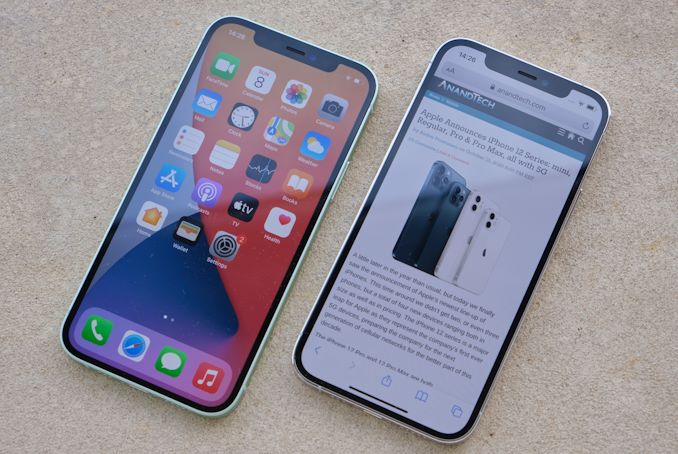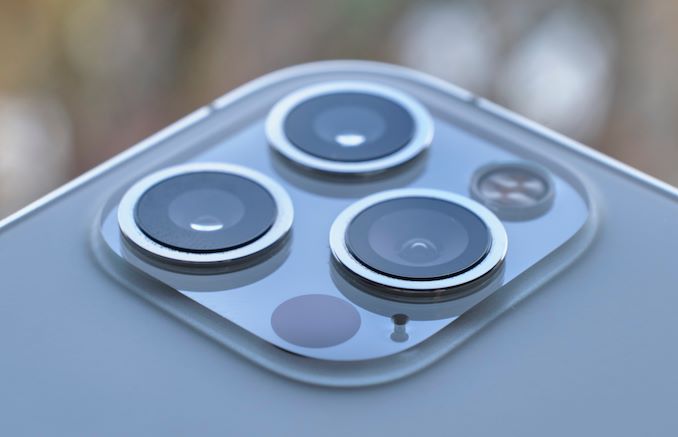The iPhone 12 & 12 Pro Review: New Design and Diminishing Returns
by Andrei Frumusanu on November 30, 2020 8:30 AM EST- Posted in
- Mobile
- Apple
- Smartphones
- Apple A14
- iPhone 12
- iPhone 12 Pro
Conclusion & End Remarks
We’ve had the new iPhones for a few weeks now, admittedly pushing out this review in favour of coverage of Apple’s newest Apple Silicon M1 devices. As I’m finally finishing up this iPhone review, the one feeling I have is that I’m not all too excited for this new generation of phones, with several factors coming into play.
First of all, design-wise, the new iPhone 12 series are definitely a breath of fresh air for Apple’s device line-up. Finally dropping the industrial design look that was adopted 3 years ago by the iPhone X, the new iPhone 12’s design is a mix of the old and new. There’s undoubtedly homage to the iPhone 4 and 5 era which featured also featured flat metal frames in their design, and it does make the iPhone 12 series stand out versus any other phone today.
Whilst design and looks are one side of the coin, the other side is actual usability and ergonomics. In this regard, I’m just not a very big fan of Apple’s choices here as I outright feel the iPhone 12s are a step backwards compared to the iPhone 11 series. Although the width of the phones isn’t any larger on the new models, they just feel noticeably bigger in the hand due to the right-angle frame edges. I ask myself as what exactly was the reason in the first place that over the years, we transitioned to rounded phones, with various vendors investing into curved front and back glass devices, if it was not for the benefit of better ergonomics, and for the devices to fit better in our fleshy meat hands. I mean, what’s the point in making the new iPhones thinner, and lose out on battery capacity, if they don’t actually feel thinner in the hand? I know it’s a very subjective topic and people might not have the same strong opinion, but even after a few weeks I still prefer to go back to an iPhone 11 Pro because of the more natural ergonomics.
Build-quality wise, the new iPhones are great and feel extremely solid. I prefer the aluminium iPhone 12 over the steel 12 Pro due to it not collecting fingerprints and actually being much lighter, although the frosted matte glass back panel of the 12 Pro definitely has the much better feeling finish.
The displays of the iPhone 12’s are good, with the Pro devices having the better quality displays of the series, having a higher brightness and better viewing angles, although the practical differences between the two models aren’t all that great.
The fact that both the iPhone 12 and 12 Pro have the same resolution OLED displays this generation means that the feature differences this year are far smaller compared to last year’s iPhone 11 vs 11 Pro juxtaposition. This is a major change in the product line-up that in my opinion makes the lower-end variants significantly more interesting and more viable versus the more expensive Pro-counterparts.
The lack of a higher refresh-rate display option is a pity, but given the battery impact on other devices on the market, it might have been wise for Apple to hold this feature back until the technology has matured enough to ensure a non-negative user experience. As it stands, the battery life of the iPhone 12 and 12 Pro is in line with last year’s 11 Pro – which is excellent.
Performance of the new iPhone 12’s is both a strength-point as well as a weakness. The strength is that the new A14 chip is by far the best performing mobile SoC on the market right now. The weakness is, that compared to the A13, the generational improvements aren’t as great as prior A-series SoC jumps. In every-day usage, I’m sure the iPhone 12s are faster than the iPhone 11 devices, but I’d be hard-pressed to actually notice this without a side-by-side comparison. This includes CPU-side use-cases as well as GPU-side gaming use-cases, which see an even smaller generational upgrade.
On the camera side, Apple has kept the base formula of the iPhone 11 series, and resorted to smaller generational improvements. The largest improvement is a new HDR algorithm that is actually quite noticeable in daylight shots, and produces better tone-mapping and contrast-rich pictures. The ultra-wide-angle module especially sees much better image processing with more details. Oddly enough, the telephoto module on the 12 Pro has been consistently worse than the 11 Pro in our testing, with far less detail retention.
In low-light, the camera’s new f/1.6 aperture does allow for slightly better light capture, however the general processing and Night Mode doesn’t seem to have been changed much this generation. The ultra-wide-angle’s added capability of Night Mode means that it’s not completely useless in low-light, although it’s not quite as high quality as competitor solutions.
While I’m relatively happy with the camera experience, I feel like Apple didn’t quite push the boundaries as far as they could have. The competition both has better hardware, and has made huge strides in terms of computational photography and image processing, and there’s just better phone cameras out there right now.
Good Improvements, Although Not Very Exciting
I have two verdicts for the iPhone 12’s, one for the 12 Pro and one for the regular iPhone 12.
For the iPhone 12 Pro, unless you’re coming from an older-generation device, there’s very few selling-points compared to the iPhone 11 Pro. The screen is slightly better, the cameras are slightly better, and it’s posting slightly better performance. Battery life being the same and the ergonomics being arguable, that only leaves 5G as the major unique feature of the new device. At this stage of 5G deployment, whether a 5G-compatible device is worth the upgrade for you is going to be highly dependent on your location and carrier. At $999 or 1159€ I feel that the phone should have offered something more to make the choice easier.
The iPhone 12, on the other hand, is in my opinion Apple’s best iPhone in a very long time. At $799 / 909€, the only real tangible thing you’re losing out on versus the Pro is the telephoto module. You’re still getting an excellent screen, the same performance, almost identical battery life, and otherwise identical everyday camera experience for $200 less. Even though it’s $100 more expensive than the iPhone 11, the much better screen elevates it into a better tier-category. The fact that it’s a lighter phone and fingerprint resistant aluminium is actually a plus in my book.
The iPhone 12 mini and 12 Pro Max are still open for debate as we didn’t have a chance to review them yet. If you’re looking for a small phone, the 12 mini looks like a perfect device, while if you’re looking for a max-sized phone and don’t mind the larger price-tag, the 12 Pro Max also certainly going to be a good option, especially if the new camera module hardware pans out.












101 Comments
View All Comments
GC2:CS - Monday, November 30, 2020 - link
Displaymate says peak white is like 10% down compared to 11 Pro.11 Pro was 8% down from the XS but at higher max brightness the efficiency suffers (apple said 15% better isoperf).
That combined with the A14 would pretty much eliminate any fears of downgraded battery life. Unless you turn 5G on.
KPOM - Monday, November 30, 2020 - link
Still better than what iPhones can draw from normal Qi chargers.calleng - Monday, November 30, 2020 - link
All this talk about edges and surface of the phone is bull. Who uses an iphone without a proper case. Maybe apple should make them out of rubber.Andrei Frumusanu - Monday, November 30, 2020 - link
If we didn't care about the design then why bother with a heavier steel variant then? I don't care for cases for one and use all my phones naked.zanon - Monday, November 30, 2020 - link
calleng is completely off base but I do sympathize with Apple being tugged multiple ways here. If 70-80% of owners use a case, well, 20-30% naked is still a LOT. Tens of millions, and reviewers in particular always mention it, and it's what people feel in the store too. So it definitely matters to pay major attention to a quality naked phone experience. Yet that doesn't change a super majority using it with a case, and Apple can't possibly be completely ignoring that either."Why bother with a heavier steel variant then" though really is an interesting question give the noticeable weight difference. There are lots of other premium materials, titanium of course but also all sorts of alloys and even ceramics that Apple has worked with in the past. Steel is certainly really versatile and can be very tough, but it's still a curious choice for a company that has tended to pay a lot of attention to weight and hand feel. As you say in the review it's genuinely debatable if it even is more "premium" here, and it's not like Apple doesn't have serious materials chops. They have high end titanium case options for their watches as well.
cha0z_ - Tuesday, December 1, 2020 - link
The last pools I saw on the subject (this summer), it was 50% using their phones naked and 50% with a case. ;) the pool had around 40 000 voters.cha0z_ - Tuesday, December 1, 2020 - link
Same, used all of my phones totally naked (no case, no screen protector) - all in perfect condition.FunBunny2 - Tuesday, December 1, 2020 - link
from what I gather, most cracked screens are from butt compression due to carrying in back pocket. spongy rubber-ish case won't stop that.iphonebestgamephone - Tuesday, December 1, 2020 - link
Look harder and youll see how its not perfect.Unashamed_unoriginal_username_x86 - Tuesday, December 1, 2020 - link
I know it's not as comfortable or sexy, but I hope you put something on when you go outside. I don't want you getting arrested!